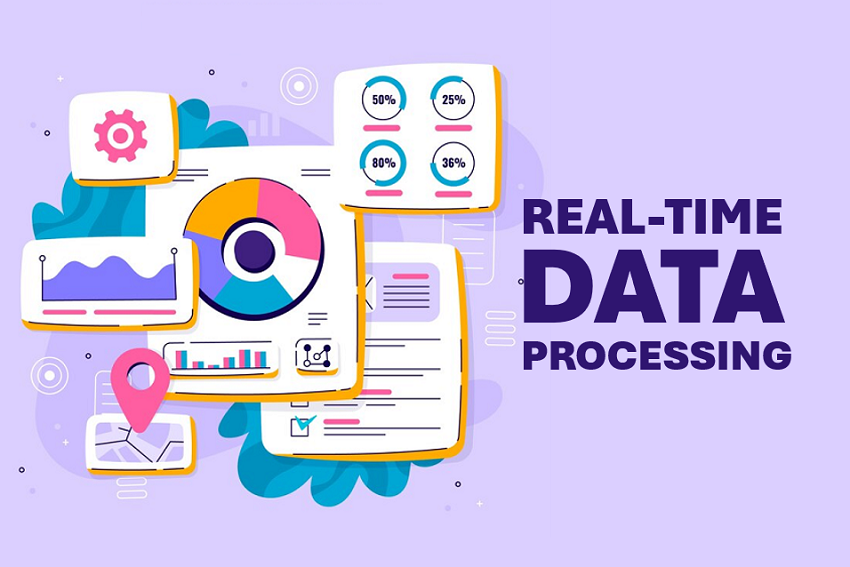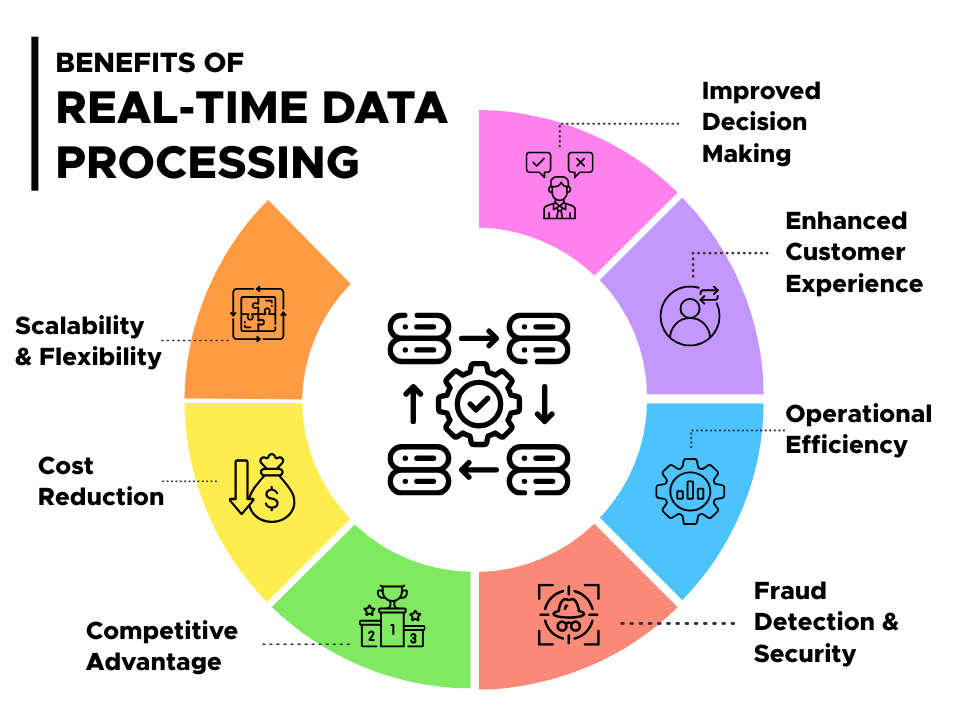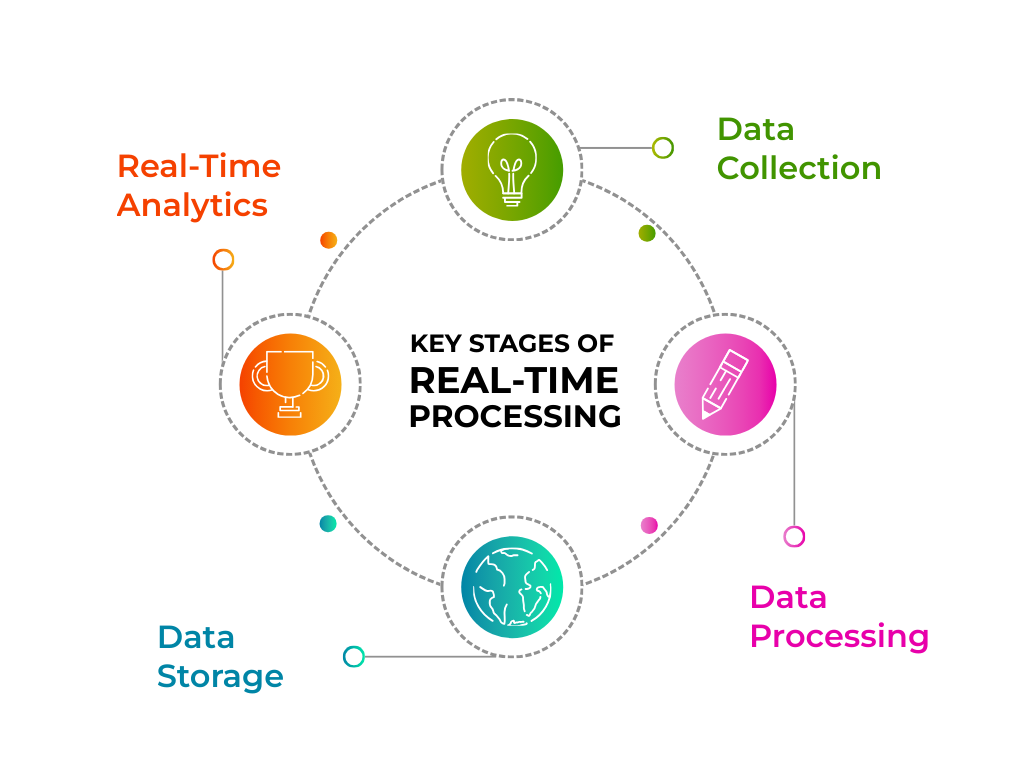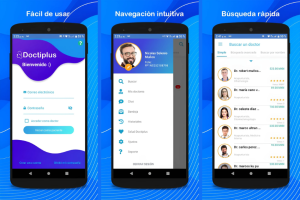Real-time data processing is a new technique due to which the data is computed and used immediately at the time it is produced and does not have to wait for batch processing. This capability is especially useful in the current world since it will enable organizations and businesses to grasp the existing and new scenarios and act fast.
The various benefits of real-time processing are improved decisions, greater operational effectiveness, and enhanced capabilities to provide targeted solutions to users. This is becoming increasingly important as the need for instantaneous analysis of the vast amounts of data present in the current digital economy is emerging as a key factor to enhance business competitiveness.
Let’s explore what real-time data processing is, its benefits, the challenges involved in its implementation, and how to overcome these challenges to stay ahead.
What is Real-Time Data Processing?

Real-time processing involves the processing of data in real-time that is as soon as the data is collected or received, it is immediately processed. It is particularly valuable in the applications where fast analysis is needed, for instance, stock trading, fraud monitoring, telecommunications, and online gambling.
Real-time processing systems are those in which data streams are received, transformed and analyzed in real time to provide the organization with real-time information to make decisions on in the shortest time possible. This is done by utilizing technologies and frameworks associated with handling high velocity data to reduce impedance thereby allowing easy response to dynamic environment.
Real-time data processing and controls are highly beneficial to organizations in the aspects to control quick and operational efficiency, customer satisfaction and flexibility in market movements.
Real-time Data Processing vs Batch Processing
To handle streaming data for IT companies, healthcare facilities, financial institutions, and other domains, usually two approaches are followed, i.e. real-time processing vs batch processing. Unlike real-time processing, in batch processing, the data is processed in various batches at regular intervals.
Both real-time data processing and batch processing aim to convert raw data into actionable information for companies. However, they differ significantly based on the following aspects:
| Criteria | Real-Time Data Processing | Batch Processing |
|---|---|---|
| Data Handling | Works with continuous streams of data. | Works with large datasets collected over time. |
| Latency Level | Lower latency as output is received within milliseconds. | Higher latency as output can take minutes to hours. |
| Cost | Complex and expensive as processing requires high-performance hardware and software. | Efficient and simple as it processes data in bulk for businesses. |
| Time Limit | Specified time limit, else the system can fail. | There is no time limit. |
| Suitability | Best for applications requiring immediate responses and real-time monitoring. | Ideal for non-urgent, periodic data analysis. |
| Decision-Making Speed | Enables instant insights and automated actions. | Results are available after processing is completed, causing delays. |
Benefits of Real-Time Data Processing

For businesses, delayed insights can often lead to missed opportunities. Real-time data processing can benefit organizations in the following ways:
Improved Decision-Making
It empowers organizations to make instant decisions in a specific period with the lowest percentage of error margin. Such access leads to efficient and quick decision making because the information is current compared to occasions where information is analyzed and passed to decision makers after a longer time span. Thus, the use of real-time data helps in making the right decisions for the development of a business, as well as in avoiding potential problems and embracing beneficial opportunities when they emerge.
Enhanced Customer Experience
Today customers have higher expectations than ever, they require fast response in terms of services. In this case, real-time data processing is essential. Thus, by analyzing customer interactions and behaviors in real-time, business salespeople can successfully meet the customers’ needs for higher satisfaction and thus loyalty levels. The effectiveness of timely data is that it allows the company to answer customers’ queries immediately, address their concerns immediately, and provide recommendations which would also in turn build a better customer relationship.
Operational Efficiency
It helps minimize intervals for business processes considering that the information is immediately analyzed. It helps organizations to have a way of measuring performance, determine areas that need improvement and correct them straight away. For instance, in supply chain management efficiency, there will be real-time replenishment of stock, minimization of the excess stock and timely delivery of the products. In a similar manner, in manufacturing, real-time monitoring can aid in increasing productivity, reducing on time and increasing quality check.
Fraud Detection and Security
Nowadays, threats are becoming more complex and that is why it is crucial to perform data processing in real-time to ensure protection and fraud detection. The ability to monitor transactions and users’ activities perpetually enables organizations to identify threats and threats while they are happening, hence preventing them. Such a strategy reduces the possibility of losses and keeps customers’ data safe, thus creating a safe environment for both the business and consumers.
Competitive Advantage
The possibility of analyzing data in real-time can be a crucial factor determining the success of a company in a competitive environment. In the competitive world, the use of real-time analysis enables an organization to surpass competitors as they are able to respond to variations in the markets and customers’ needs faster. It makes the business more flexible, allows for the introduction of new goods and services and the grabbing of the market share. Real-time data processing also drives cross inter-and intra-functional cooperation as well as knowledge promotion, thereby encouraging the ongoing enhancement of organizational processes.
Cost Reduction
Real-time data processing can save a lot of money in terms of optimizing operations and preventing problems. An efficient method of reducing operational costs is by increasing resource utilization, reducing wastage and avoiding avoidable costs. Further, real-time insights can be used in improving the marketing efforts to make sure that the efforts are well directed at the desirable channels and campaigns thus making full utilization of the resources in the right manner in a bid to maximize on the returns from the investments made.
Scalability and Flexibility
These systems provide complete flexibility and scalability hence implementing changes in the business environment do not put extra pressure on organizations. These systems perform very well when there are large volumes of data that have to be processed. This scalability is a guarantee that companies get to access real-time analyzes irrespective of its scale or dimension. In addition, real-time data processing helps with cloud-based solutions which make them flexible in terms of deployment and their compatibility with existing IT environment.
Key Applications for Real-Time Data Processing
Real-time data processing helps various businesses navigate the changing environment around them and make informed decisions. Let us explore some cases of the same use in different industries:
Financial Trading
In stock markets, a few seconds of delay often can make a trader loss or gain money. With high-quality real-time data, machine learning classifiers can provide instant analysis of market fluctuations, algorithmic trading, and risk assessment. Thus, traders can make a more educated decision about curbing losses and maximizing profits.
Fraud Detection
Since data is processed as and when it is generated, financial institutions can use anomaly detection algorithms to detect fraudulent transactions, account takeovers, and cyber threats within the initial few seconds before they escalate. This way, companies can flag suspicious activities and send automated alerts to concerned people.
Personalized Product Recommendations
eCommerce brands generally use real-time data processing to analyze user behavior, purchase history, and browsing patterns. AI-driven algorithms process this data instantly to suggest relevant products to the customers, improving engagement and conversion rates.
Security and Surveillance
Companies often use real-time data processing to analyze live CCTV feeds so that they can detect unusual activities and people and alert security staff. By doing so, they can ensure that the premises and people within the premises are secure from attacks.
Automated Healthcare Monitoring
With real-time data processing, it is possible to instantly monitor vitals like heart rate, oxygen levels, or ECG patterns through wearable devices. If there are any abnormalities, the system triggers real-time alerts for early intervention. This enhances patient safety, reduces hospitalization, and enables proactive care.
Quality Control
Manufacturing businesses always aim to launch new products consistently while maintaining quality. By collecting and processing real-time data related to product dimensions, material consistency, temperature, and packaging through sensors, manufacturing units can process it to optimize production. Overall, companies reduce downtime and failures, saving a good chunk of money.
Live Sports Analytics and Performance Optimization
Through real-time data processing, sports teams, broadcasters, and coaches can analyze and respond to in-game events. They can process a wide range of data, such as player movements, ball trajectory, weather conditions, team performance, live scores, and audience reactions, to adapt strategies mid-game and make more accurate predictions about game scores. Additionally, real-time insights can help coaches forecast possible injuries and make necessary changes in players’ movements or strategies to enhance their performance.
Weather Forecasting
Real-time data processing helps meteorologists analyze satellite images and atmospheric sensors to predict weather changes instantly. This allows for timely disaster warnings, flight safety decisions, and agricultural planning. Accurate real-time weather updates minimize risks, improve preparedness, and help businesses and governments take proactive measures against extreme weather conditions.
Key Stages of Real-Time Data Processing

Real-time data processing involves several steps that can change based on how the system is built. The following is a generalized version of the different stages that you should know:
- Data Collection: Data is generated every second from multiple sources like IoT devices (smart devices and wearables), financial transactions, social media feeds (Instagram, Facebook, Twitter, TikTok), GPS, user behavior data (user activity and session duration), CCTV cameras, biometric scanners, and more. This data is collected as and when it is generated for real-time processing.
- Data Processing: At this stage, data is converted into a suitable format (by using data transformation techniques or tools) to integrate with existing systems and applications. The formatted data is then checked for errors, inconsistencies, duplicates, and missing/outdated information. By using manual data enrichment techniques and subject matter expertise, relevant information is added to make the dataset comprehensive and up to date.
- Data Storage and Real-Time Warehousing: The updated and cleansed data is stored securely in a centralized repository for quick and seamless access. There are several types of storage available for different needs. For example, in-memory databases can be used for quick access, while analytical data storage can be used for historical data & pattern analysis.
- Real-Time Analytics: Businesses use data visualization techniques and machine learning to extract and analyze useful insights from data. This data helps them identify sales patterns, market trends, and user preferences to make better decisions and optimize their services or products.
Popular Examples of Real-Time Data Processing
Real-time data processing benefits almost every industry in some way or another. The two most common examples of real-time data processing in everyday life are:
Google Maps
Ever wondered how the app knows the shortest route or where traffic is the worst? It pulls data from GPS, traffic cameras, and live user feedback to analyze road conditions in real time. Based on that, it suggests faster routes, helping you avoid congestion and reach your destination quicker.
Netflix
The popular video streaming platform uses real-time data processing in its recommendation systems. How? The platform collects information from every user visit, like the titles they are watching, whether they have finished them, and how they rate those titles to update their AI models and ensure more accuracy in suggestions provided by their recommendation systems. As a result, users get relevant recommendations about what they should watch next based on their current preferences.
Is In-House Real-Time Data Processing Holding Your Business Back?
Many businesses think that they can remain cost-effective and efficient by handling data processing in-house. However, that is not true. In-house data processing is becoming more challenging for businesses due to the following reasons:
High Infrastructure Investment is Required
Real-time data processing often requires massive investment in high-performance servers, storage solutions, and data streaming tools. Since real-time data grows daily, businesses need to spend constantly on the maintenance of infrastructure and tool upgrades to make sure they are efficient.
The Complexity of Finding the Right Talent
Subject matter expertise is required to manage distributed data systems and streaming frameworks. For businesses, hiring, training, and retaining data experts is difficult due to budget constraints.
Data Latency and Processing Issues
Many businesses struggle with real-time data ingestion, transformation, and analysis due to poorly optimized pipelines. Ensuring millisecond-level processing speeds requires efficient parallel computing and load balancing, which can be complex.
Compliance and Security Risks
Patient records and financial transactions are highly sensitive information and need strong encryption, authentication, and compliance with GDPR and HIPAA. Many businesses struggle to secure this data in-house, which makes them vulnerable to breaches and penalties more often than not.
Downtime Issues
Real-time data processing systems demand continuous monitoring, auto-scaling, error handling, and redundancy mechanisms. Without robust fault tolerance, even minor system failures can cause data loss or downtime, affecting business operations.
How is Outsourcing Real-Time Data Processing the Smarter Choice?
When companies come across issues with managing real-time data processing, they often look for service providers to ensure efficiency in the process without the operational burden.
No Heavy Investments
Service providers have the infrastructure with immense computational power. Thus, businesses have to only pay for the resources, freeing them from maintaining and upgrading expensive infrastructure. For businesses, this means reduced operational costs while ensuring optimal performance and scalability.
Faster Deployment
Setting up an in-house data pipeline for real-time processing takes months of development and fine-tuning, and there is always a risk of not achieving the desired accuracy. When businesses outsource data processing services, they can often get ready-to-use data pipelines that the providers have been using for a long and thus can avoid project delay.
Faster and Accurate Insights
Service providers leverage AI-powered analytics systems and real-time dashboards to ensure businesses get instant and valuable insights. This helps in faster decision-making, improved forecasting, and better customer engagement without internal processing delays.
Better Security and Compliance
Service providers make sure that your business data remains protected by adhering to strict NDAs and best data security practices, such as end-to-end data encryption, role-based access controls, and secure file sharing. Most web scraping service providers have ISO and HIPAA certifications for guaranteed data security. They keep their team updated on GDPR, CCPA, HIPAA, and other data privacy regulations to ensure the responsible use of sensitive information.
Key Takeaway
As business data is growing continuously, its efficient processing in real-time is becoming essential for improved decision-making, operational efficiency, and customer experience. Depending upon their project needs, budget requirements, and other aspects, businesses can either opt for an in-house approach or outsource data processing services to reliable providers.
However, before opting for any of these two approaches, it becomes critical for businesses to decide on areas where real-time insights can make the most impact. This will help them prioritize which type of data they should prioritize first for real-time processing and avoid operational chaos.


